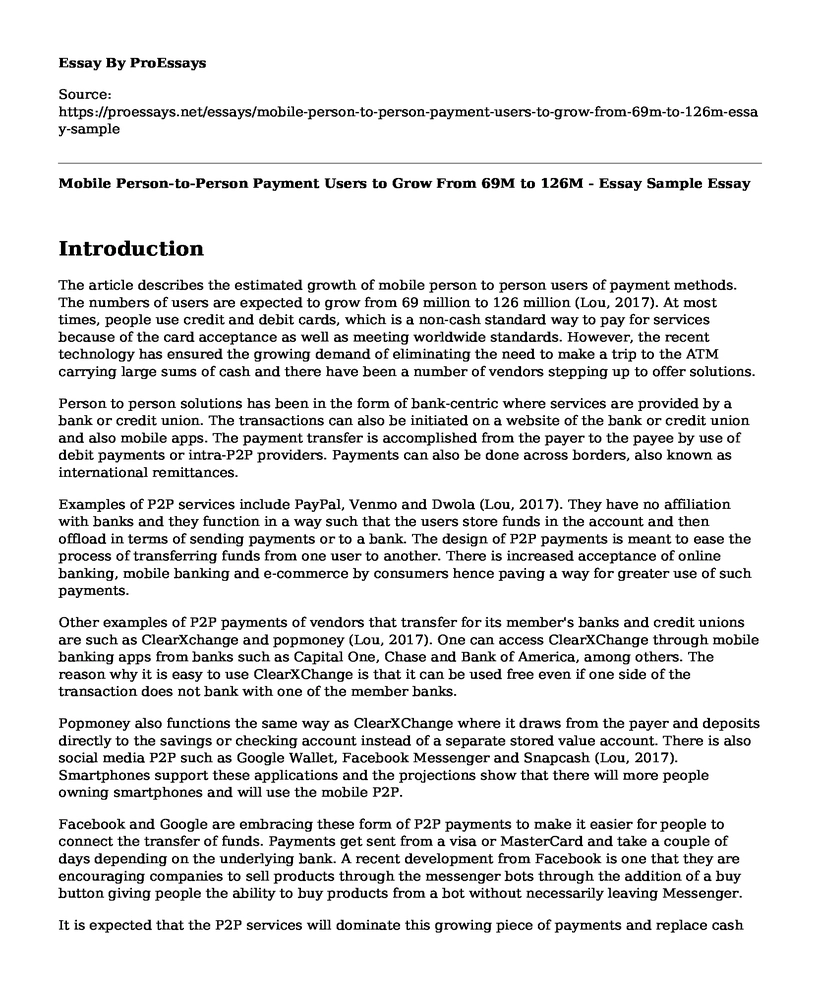Introduction
The article describes the estimated growth of mobile person to person users of payment methods. The numbers of users are expected to grow from 69 million to 126 million (Lou, 2017). At most times, people use credit and debit cards, which is a non-cash standard way to pay for services because of the card acceptance as well as meeting worldwide standards. However, the recent technology has ensured the growing demand of eliminating the need to make a trip to the ATM carrying large sums of cash and there have been a number of vendors stepping up to offer solutions.
Person to person solutions has been in the form of bank-centric where services are provided by a bank or credit union. The transactions can also be initiated on a website of the bank or credit union and also mobile apps. The payment transfer is accomplished from the payer to the payee by use of debit payments or intra-P2P providers. Payments can also be done across borders, also known as international remittances.
Examples of P2P services include PayPal, Venmo and Dwola (Lou, 2017). They have no affiliation with banks and they function in a way such that the users store funds in the account and then offload in terms of sending payments or to a bank. The design of P2P payments is meant to ease the process of transferring funds from one user to another. There is increased acceptance of online banking, mobile banking and e-commerce by consumers hence paving a way for greater use of such payments.
Other examples of P2P payments of vendors that transfer for its member's banks and credit unions are such as ClearXchange and popmoney (Lou, 2017). One can access ClearXChange through mobile banking apps from banks such as Capital One, Chase and Bank of America, among others. The reason why it is easy to use ClearXChange is that it can be used free even if one side of the transaction does not bank with one of the member banks.
Popmoney also functions the same way as ClearXChange where it draws from the payer and deposits directly to the savings or checking account instead of a separate stored value account. There is also social media P2P such as Google Wallet, Facebook Messenger and Snapcash (Lou, 2017). Smartphones support these applications and the projections show that there will more people owning smartphones and will use the mobile P2P.
Facebook and Google are embracing these form of P2P payments to make it easier for people to connect the transfer of funds. Payments get sent from a visa or MasterCard and take a couple of days depending on the underlying bank. A recent development from Facebook is one that they are encouraging companies to sell products through the messenger bots through the addition of a buy button giving people the ability to buy products from a bot without necessarily leaving Messenger.
It is expected that the P2P services will dominate this growing piece of payments and replace cash and check with a seamless ad secure method of payments. The mobile app that wins the category of being the best app to use by every generation is Venmo. On the other hand, PayPal has been recognized when it comes to P2P payments. P2P payments will be faster and reliable for the great numbers that use smartphones.
Reference
Lou Grilli (2017). P2P-A comprehensive look at person-to-person payments. The payments Review. Retrieved from http://www.thepaymentsreview.com/a-look-at-p2p-payments
Cite this page
Mobile Person-to-Person Payment Users to Grow From 69M to 126M - Essay Sample. (2023, Feb 27). Retrieved from https://proessays.net/essays/mobile-person-to-person-payment-users-to-grow-from-69m-to-126m-essay-sample
If you are the original author of this essay and no longer wish to have it published on the ProEssays website, please click below to request its removal:
- The Budget Restaurant Business Plan - Course Work Example
- Is HIPAA Sufficient? Essay Example
- Planning and Budgeting in Pharmacy Services - Paper Example
- Essay Sample on Christopher Ward Expand to Japan
- Paper Example on Advertising & Marketing Agency: Concentrating on Increasing Market Share
- Long-Term Liabilities: Debts, Loans & Taxes - Essay Sample
- Financial Markets Act (2013): Disclosure Requirements for Investors - Essay Sample







